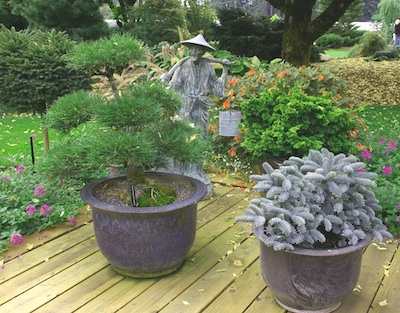My gardens are filled with a plethora of perennials, flowering shrubs, annuals and dwarf conifers.
I prefer them to full-size pines, junipers, cypress and larch, because they mature to less than 15 feet. That’s more in scale with the average suburban yard than a towering 80-foot white pine or a 50-foot arborvitae.
Standard evergreens add feet to their height every year, but their dwarf siblings grow mere inches in a year. Most dwarfs add 3 to 6 inches of height annually and are between 3 and 6 feet tall after ten years. They can be upright cones such as dwarf Alberta spruce, cascading trees like weeping larch or small green mounds such as dwarf Mugo pines. There are narrow upright types like ‘North Pole’ arborvitae and ground hugging ones such as trailing Norway spruce, too. All are strong design elements that make a landscape special.
.jpg)
Dwarfs like ‘North Pole’ arborvitae grow for years in containers. Behind this pot is a fully mature ‘North Pole’, which matures to only 15 feet tall. Photo courtesty of Proven Winners.
This is the time of year to search garden centers for deeply discounted dwarfs and plant them. As temperatures cool, newly planted conifers grow extensive roots systems and settle in place for winter. Plant them a bit high; dig a hole twice the diameter of the plant pot and the same depth. Throw in a shovel of compost and then spread the root ball over it. Mulch thickly and water regularly until the ground cools.
Also, go light on fertilizer or skip in the spring; scant nutrients keep dwarfs small. Their roots will mine the soil for enough nitrogen and other elements to keep the trees healthy.

Tiny conifers are perfect for patios, decks and in perennial beds. Photo by Doreen G. Howard.
Miniature conifers (which are tiny dwarfs) grow no more than 12 to 15 inches high and are perfect for containers, rock gardens and as perennial bed accents. Drought tolerant cultivars do best in containers and rock garden, because they can go long periods without water. ‘Blue Star’ juniper, ‘Tom Thumb’ arborvitae and ‘Jean’s Dilly’ Alberta spruce are some to look for.
Miniatures in containers can remain outside during winter, even in the frigid north. Either wrap the pot with burlap or bury it in mulch to maintain dormancy on sunny January days.


.jpg)









